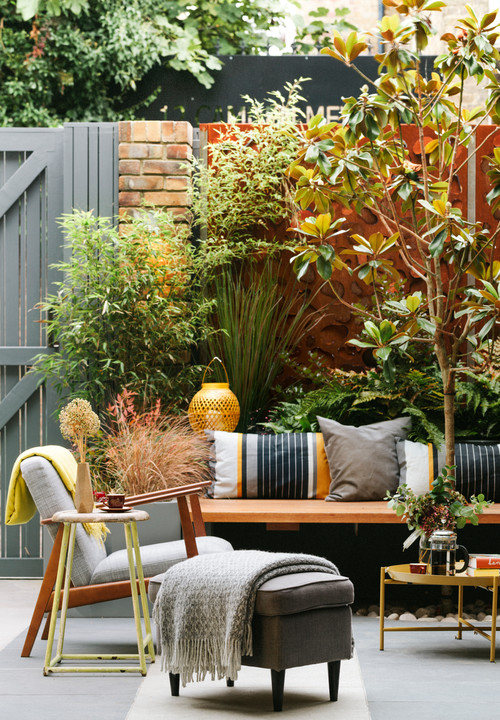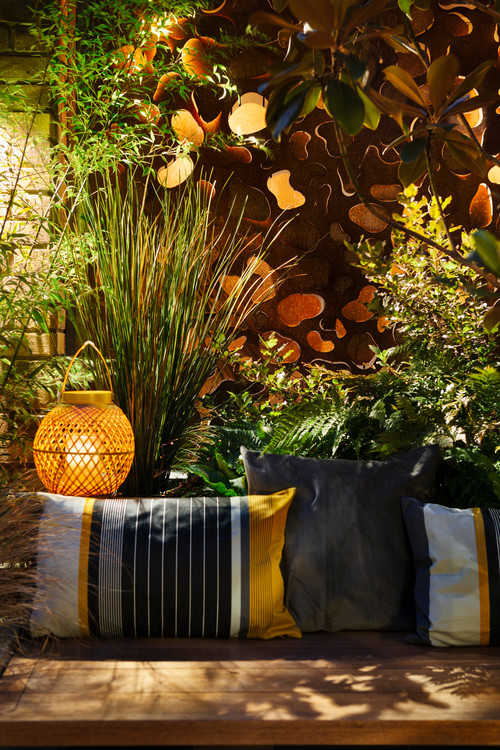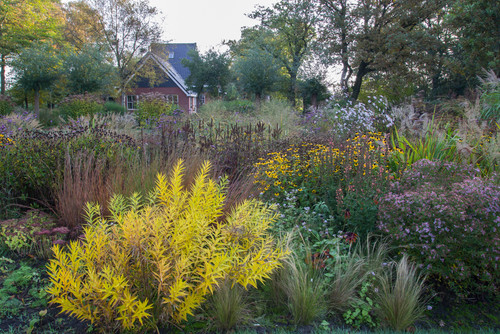By: Lauren Dunec Hoang
We’re quick to notice the dramatic, brightly colored leaves this time of year, but there’s a more subtle layer of beauty to fall gardens that’s easy to overlook. As colors begin to fade, the contrast of different plant forms and textures — the soft plumes of ornamental grasses, crinkled leaves of deciduous trees, spiky needles of conifers and dried seed heads of perennial flowers — can create a landscape of long-lasting fall and winter beauty.
Take a visual tour of four gardens that use a combination of trees, shrubs, grasses and perennials, as well as interesting hardscape materials, to celebrate autumn through form and texture.
1. A Pint-Sized Mews Courtyard in London
By using texture-rich building materials, landscape designer Georgia Lindsay of London-based Georgia Lindsay Garden Design can pack a lot of interest into small city gardens with limited planting space.
For example, consider the design of this courtyard garden in converted stables, or “mews,” in London’s Camden neighborhood. Each element — including the smooth concrete floor, exposed existing brick walls, slatted wood gate and three-dimensional Cor-Ten steel wall panels — adds texture to the space. Then furniture, cushions and throw blankets come in.
A close-up of the built-in bench gives us a view of the Cor-Ten panels, which, when backlit, create a luminous textural backdrop. The wall-mounted panels were designed with cutouts and three-dimensional flaps that echo the size and shape of the leaves of the magnolia tree planted at the center of the courtyard.
A close-up of the built-in bench gives us a view of the Cor-Ten panels, which, when backlit, create a luminous textural backdrop. The wall-mounted panels were designed with cutouts and three-dimensional flaps that echo the size and shape of the leaves of the magnolia tree planted at the center of the courtyard.
Plants in the built-in bed — such as delicate ornamental grasses, lace-like ferns and glossy-leafed mirror plant (Coprosma sp.) — stand out with bronze and green hues and a variety of leaf textures and forms.
Lindsay topped the planting area for the magnolia with a top-dressing of chunky river stones, taking yet another opportunity to add textural contrast to the courtyard.
Working texture into the design with the building and hardscape materials ensures that the courtyard will have year-round interest, even when plants are more bare.
2. A Landscape Designer’s Trial Garden in Pennsylvania
Landscape designer Donald Pell of Donald Pell Gardens uses the garden around his studio in East Vincent Township, Pennsylvania, as an expression of his design philosophy and to try out different planting combinations. The textures of plants and other garden elements, like hardscape and sculpture, play a starring role and give the garden year-round interest. “Flowers can be so ephemeral,” Pell says. “I generally focus on textures of foliage and bark.”
Here, the plumes of ornamental grasses (Miscanthus sinensis ‘Gracillimus’ and Miscanthus x giganteus), fading flowers of Russian sage (Perovskia atriplicifolia ‘Filigran’) and lingering seed heads of giant coneflower (Rudbeckia maxima) form a textural feast alongside a stacked stone cairn.
Caution: Some species of Miscanthus can self-seed and become invasive. Check your region for invasiveness before planting.
Pell’s advice for gardeners: “Have patience. There can be a surprise around every corner.” For example, the tall dried stalks of golden-hued moorgrass (Molinia caerulea ssp. arundinacea ‘Cordoba’) shown here in contrast with the deep burgundy large-textured leaves of kousa dogwood (Cornus kousa ‘Satomi’) was a surprising discovery.
“Molinias don’t generally stand up great in the winter,” Pell says, “but two seasons ago it turned brilliant gold and even when [it later] flopped over, it had the most vivid effect all winter. I think we’re better off when we enjoy the evolution, relax and put the pruning shears down.”
Even smaller garden vignettes offer the opportunity to work in some texture. Leaving the seed heads of astilbe (Astilbe chinensis ‘Purple Candles’) on the plant in fall allows birds to feast on the seeds and adds a rich bronze color and texture to a bed with sweetbay (Magnolia virginiana) and white-flowering Japanese anemone (Anemone x hybrida ‘Honorine Jobert’).
See this garden in other times of year | Find landscape designers in your area
3. A Meadow Garden in the Dutch Countryside
This naturalistic meadow garden located in Friesland, a province in the northwest of the Netherlands, is a tapestry of color and texture throughout the seasons. In spring and summer, perennial flowers and bright foliage stand out in ribbons of color through the ornamental grasses. In fall and winter, the texture of grasses, seed heads and stems form a more subtle display.
Did you enjoy this article? For more visit, www.houzz.com













 Not intended as a solicitation if your property is already listed by another broker. LPT Realty, LLC is a Licensed Real Estate Brokerage.
Not intended as a solicitation if your property is already listed by another broker. LPT Realty, LLC is a Licensed Real Estate Brokerage.